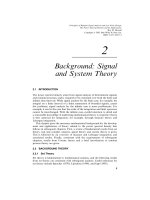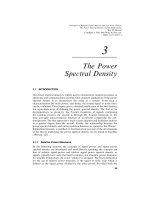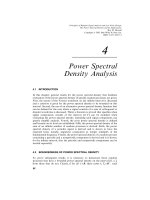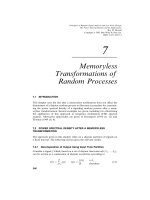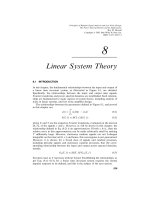Tài liệu Nguyên tắc phân tích tín hiệu ngẫu nhiên và thiết kế tiếng ồn thấp P7 ppt
Bạn đang xem bản rút gọn của tài liệu. Xem và tải ngay bản đầy đủ của tài liệu tại đây (222.79 KB, 23 trang )
7
Memoryless
Transformations of
Random Processes
7.1 INTRODUCTION
This chapter uses the fact that a memoryless nonlinearity does not affect the
disjointness of a disjoint random process to illustrate a procedure for ascertain-
ing the power spectral density of a signaling random process after a mem-
oryless transformation. Several examples are given, including two illustrating
the application of this approach to frequency modulation (FM) spectral
analysis. Alternative approaches are given in Davenport (1958 ch. 12) and
Thomas (1969 ch. 6).
7.2 POWER SPECTRAL DENSITY AFTER A MEMORYLESS
TRANSFORMATION
The approach given in this chapter relies on a disjoint partition of signals on
a fixed interval. The following section gives the relevant results.
7.2.1 Decomposition of Output Using Input Time Partition
Consider a signal f which, based on a set of disjoint time intervals +I
, ..., I
,
,,
can be written as a summation of disjoint waveforms according to
f (t) :
,
G
f
G
(t) f
G
(t) :
f (t)
0
t+ I
G
elsewhere
(7.1)
206
Principles of Random Signal Analysis and Low Noise Design:
The Power Spectral Density and Its Applications.
Roy M. Howard
Copyright
¶
2002 John Wiley & Sons, Inc.
ISBN: 0-471-22617-3
If such a signal is input into a memoryless nonlinearity characterized by an
operator G, then the output signal g : G( f ) can be written as a summation of
disjoint waveforms according to
g(t) :
,
G
g
G
(t) g
G
(t) :
g(t)
0
t + I
G
t , I
G
(7.2)
where, as detailed in Section 2.3.3,
g
G
(t) :
G( f
G
(t))
0
t+ I
G
t, I
G
(7.3)
7.2.1.1 Implication If all signals from a signaling random process can be
written as a summation of disjoint signals, then this result can be used to define
each of the corresponding output signals after a memoryless transformation
and hence, define a signaling random process for the output random process.
As the power spectral density of a signaling random process is well defined (see
Theorem 5.1), such an approach allows the output power spectral density to
be readily evaluated.
Clearly, the applicability of this approach depends on the extent to which
signals from a signaling random processes can be written as a summation of
disjoint waveforms, that is, to the extent a signaling random process can be
written as a disjoint signaling random process, which is defined as follows.
D:D S R P A disjoint signaling ran-
dom process X, with a signaling period D, is a signaling random process where
each waveform in the signaling set is zero outside the interval [0, D]. The
ensemble E
6
characterizing such a random process for the interval [0, ND]is
E
6
:
x(
, ...,
,
, t) :
,
G
(
G
, t 9 (i 9 1)D),
G
+ S
, + E
(7.4)
where S
is the sample space of the index random variable , and is such that
S
3 Z> for the countable case, and S
3 R for the uncountable case. The set
of signaling waveforms, E
, is defined according to
E
: +(, t): + S
, (, t) : 0, t : 0, t . D, (7.5)
7.2.1.2 Equivalent Disjoint Signaling Random Process Consider a
signaling random process X, defined by the ensemble
E
6
:
x(
, ...,
,
, t) :
,
G
(
G
, t 9 (i 9 1)D),
G
+ S
8
, + E
(7.6)
POWER SPECTRAL DENSITY AFTER A MEMORYLESS TRANSFORMATION
207
t
D
ψ(ζ, t)
−q
L
D (q
U
+ 1)D
Figure 7.1 Illustration of signaling waveform.
where S
8
is the sample space of the index random variable Z and the set of
signaling waveforms, E
, is defined according to
E
: +(, t): + S
8
, (7.7)
Further, assume, as illustrated in Figure 7.1, that all signaling waveforms are
nonzero only on a finite number of signaling intervals. It then follows that if a
waveform in the random process starts with the signals associated with data in
[0, D], [D,2D], ...then a transient waveform exists in the interval [0, q
3
D].
This transient is avoided for t . 0 if signals associated with data in the interval
[9q
3
D, 9(q
3
9 1)D] and subsequent intervals are included.
The following theorem states that the random process defined in Eq. (7.6)
can be written as a disjoint signaling random process with an appropriate
disjoint signaling set. A likely, but not necessary consequence of this alternative
characterization of a random process is the correlation between signaling
waveforms in adjacent signaling intervals.
T 7.1. E D S R P If all sig-
naling waveforms in the signaling set E
, associated with a signaling random
process X, are zero outside [9q
*
D,(q
3
; 1)D], where q
*
, q
3
+ +0,6Z>, then,
for the steady state case, the signaling random process can be written on the
interval [0, ND], as a disjoint signaling random process with an ensemble
E
6
:
x(
, ...,
,
, t) :
,
G
(
G
, t 9 (i 9 1)D), + E
,
G
+ S
(7.8)
T he associated signaling set E
is defined as
E
:
(, t): + S
: S
8
;%;S
8
, : (
\O
3
, ...,
O
*
),
\O
3
, ...,
O
*
+ S
8
(7.9)
where
(, t) :
(
\O
3
, t 9 (9q
3
)D) ; % ; (
O
*
, t 9 q
*
D)
0
0 - t : D
elsewhere
(7.10)
Proof. The proof of this result is given in Appendix 1.
208
MEMORYLESS TRANSFORMATIONS OF RANDOM PROCESSES
7.2.1.3 Notes All waveforms in E
are zero outside the interval [0, D]. The
probability of each waveform and the correlation between waveforms, can be
readily inferred from the original signaling random process. For the finite case
where there are M independent signaling waveforms in E
, potentially there
are MO
*
>O
3
> waveforms in E
. In most instances the waveforms from different
signaling intervals will be correlated.
7.2.2 Power Spectral Density After a Nonlinear Memoryless
Transformation
Consider a disjoint signaling random process characterized over the interval
[0, ND] by the ensemble E
6
and associated signaling set as per Eqs. (7.4) and
(7.5). If waveforms from such a random process are passed through a
memoryless nonlinearity, characterized by an operator G, then the correspond-
ing output random process Y is characterized by the ensemble E
7
and
associated signaling set E
, where
E
7
:
y(
, ...,
,
, t) :
,
G
(
G
, t 9 (i 9 1)D),
G
+ S
, + E
(7.11)
and
E
: +: (, t) : G[(, t)], + S
, + E
, (7.12)
Here, P[(, t)] : P[(, t)] : P[]. Clearly, the memoryless nonlinearity does
not alter the signaling random process form, and the following result from
Theorem 5.1 can be directly used to ascertain the power spectral density of the
output random process,
G
7
(ND, f ) : r"( f )" 9 r"
( f )";r"
( f )"
1
N
sin(Nf /r)
sin(f/r)
(7.13)
; 2r
K
G
1 9
i
N
Re[eHLG"D(R
>G
( f ) 9 "
( f )")]
G
7
( f ) : r"( f )" 9 r"
( f )";r"
( f )"
L\
( f 9 nr)
(7.14)
; 2r
K
G
Re[eHLG"D(R
>G
( f ) 9 "
( f )")]
where r : 1/D and
, "( f )", and R
>G
are defined consistent with the
POWER SPECTRAL DENSITY AFTER A MEMORYLESS TRANSFORMATION
209
definitions given in Theorem 5.1. For example, for the countable case P[] : p
A
and
( f ) :
A
p
A
(, f ) "( f )" :
A
p
A
"(, f )" (7.15)
R
>G
( f ) :
A
A
>G
p
A
A
>G
(
, f )*(
>G
, f ) (7.16)
where (, f ) :
"
(, t)e\HLDR dt.
7.2.3 Extension to Nonmemoryless Systems
It is clearly useful if the above approach can be extended to nonmemoryless
systems. To facilitate this, it is useful to define a signaling invariant system.
7.2.3.1 Definition — Signaling Invariant System A system is a signaling
invariant system, if the output random process, in response to an input
signaling random process is also a signaling random process and there is a
one-to-one correspondence between waveforms in the signaling sets associated
with the input and output random processes, that is, if E
: +
G
, and
E
: +
G
, are, respectively, the input and output signaling sets, then there
exists an operator G, such that
G
: G[
G
].
A simple example of a signaling varying system is one where the output y,
in response to an input x is defined as, y(t) : x(t) ; x(t/4). For the case where
the input is a waveform from a signaling random process the output is the
summation of two signaling waveforms whose signaling intervals have an
irrational ratio.
7.2.3.2 Implication If a system is a signaling invariant system and is driven
by a signaling random process, then the output is also a signaling random
process whose power spectral density can be readily ascertained through use
of Eqs. (7.13) and (7.14).
7.2.3.3 Signaling Invariant Systems A simple example of a nonmemory-
less, but signaling invariant system, is a system characterized by a delay, t
"
.In
fact, all linear time invariant systems are signaling invariant, as can be readily
seen from the principle of superposition. However, the results of Chapter 8
yield a simple method for ascertaining the power spectral density of the output
of a linear time invariant system, in terms of the input power spectral density,
and the ‘‘transfer function’’ of the system.
210
MEMORYLESS TRANSFORMATIONS OF RANDOM PROCESSES
7.3 EXAMPLES
The following sections give several examples of the above theory related to
nonlinear transformations of random processes.
7.3.1 Amplitude Signaling through Memoryless Nonlinearity
Consider the case where the input random process X to a memoryless
nonlinearity is a disjoint signaling random process, characterized on the
interval [0, ND], by the ensemble E
6
:
E
6
:
x(a
, ..., a
,
, t) :
,
G
(a
G
, t 9 (i 9 1)D), a
G
+ S
, + E
(7.17)
where
E
:
(a, t) : ap(t), a+ S
, p(t) :
1
0
0 - t : D
elsewhere
(7.18)
and P[(a, t)"
?Z?
M
?
M
>B?
] : P[a + [a
M
, a
M
; da]] : f
(a
M
) da. Here, f
is the den-
sity function of a random process A with outcomes a and sample space S
.
Assuming the signaling amplitudes are independent from one signaling interval
to the next, it follows that the power spectral density of X is
G
6
(ND, f ) : r"( f )" 9 r"
( f )";r"
( f )"
1
N
sin(Nf /r)
sin(f/r)
(7.19)
G
6
( f ) : r"( f )" 9 r"
( f )";r"
( f )"
L\
( f 9 nr) (7.20)
where r : 1/D, and
( f ) : P( f )
\
af
(a) da :
P( f )
:
\
af
(a) da
(7.21)
"( f )" : "P( f )"
\
af
(a) da : A
"P( f )" A
:
\
af
(a) da
If signals from X are passed through a memoryless nonlinearity G, then,
because of the disjointness of the input components of the signaling waveform,
the output ensemble of the output random process Y,is
E
7
:
y(a
, ..., a
,
, t) :
,
G
(a
G
, t 9 (i 9 1)D), a
G
+ S
, + E
(7.22)
EXAMPLES
211
where
E
: +(a, t) : G(a)p(t), a + S
, (7.23)
and
P[(a, t)"
?Z?
M
?
M
>B?
] : P[(a, t)"
?Z?
M
?
M
>B?
] : f
(a
M
) da (7.24)
It then follows that the power spectral density of the output random process is
G
7
(ND, f ) : r"( f )" 9 r"
( f )";r"
( f )"
1
N
sin(Nf/r)
sin(f/r)
(7.25)
G
7
( f ) : r"( f )" 9 r"
( f )";r"
( f )"
L\
( f 9 nr) (7.26)
where
( f ) :
%
P( f ) : P( f )
\
G(a) f
(a) da
(7.27)
"( f )" : G
"P( f )":"P( f )"
\
G(a) f
(a) da
where the following definitions have been used:
%
:
\
G(a) f
(a) da G
:
\
G(a) f
(a) da (7.28)
To illustrate these results, consider a square law device, that is, G(a) : a,
and a Gaussian distribution of amplitudes according to
f
(a) : e
9a/2
/(2
whereupon it follows that
%
:
and G
:3
(Papoulis, 2002 p. 148). Thus,
with "P( f )":"sinc( f/r)"/r, it follows that
G
6
(ND, f ) : G
6
( f ) :
r
sinc( f/r) (7.29)
G
7
(ND, f ) :
2
r
sinc( f/r) ;
r
sinc( f/r)
1
N
sin(Nf /r)
sin(f/r)
(7.30)
G
7
( f ) :
2
r
sinc( f/r) ;
( f ) (7.31)
212
MEMORYLESS TRANSFORMATIONS OF RANDOM PROCESSES
Clearly, for this case, and in general, for disjoint signaling waveforms with
information encoded in the signaling amplitude as per Eq. (7.18), the nonlinear
transformation has scaled, but not changed the shape of the power spectral
density function with frequency apart from impulsive components. For the case
where the mean of the Fourier transform of the output signaling set is altered,
compared with the corresponding input mean, potentially there is the intro-
duction or removal of impulsive components in the power spectral density.
7.3.2 Nonlinear Filtering to Reduce Spectral Spread
Many nonlinearities yield spectral spread, that is, a broadening of the power
spectral density. However, spectral spread is not inevitable and depends on the
nature of the nonlinearity and the nature of the input signal. The following is
one example of nonlinear filtering where the power spectral density spread is
reduced.
Consider the case where the input signaling random process X is character-
ized on the interval [0, ND], by the ensemble
E
6
:
x(
, ...,
,
, t) :
,
G
(
G
, t 9 (i 9 1)D),
G
+ S
, + E
(7.32)
where S
: +91, 1,, P[
G
:<1] : 0.5,
E
:
(
G
, t): (
G
, t) :
G
A
t 9 D/2
D/2
,
G
+ +91, 1,
(7.33)
and the waveforms in different signaling intervals are independent, Here, is
the triangle function defined according to
(t) :
1 ; t 91 - t : 0
1 9 t 0 - t : 1
0 elsewhere
(7.34)
Consider a nonlinearity, defined according to
G(x) :
9A
M
x : 9A
A
M
sin
2
x
A
9A - x : A
A
M
x . A
(7.35)
which is shown in Figure 7.2, along with input and output waveforms.
EXAMPLES
213
A
x
t
t
D
D
A
G(x)
−A
A
o
−A
o
Input
Output
A
o
Figure 7.2 Memoryless nonlinearity and input and output waveforms.
It follows that the output signaling random process Y is characterized on
the interval [0, ND], by the ensemble
E
7
:
y(
, ...,
,
, t) :
,
G
(
G
, t 9 (i 9 1)D),
G
+ S
, + E
(7.36)
where
E
:
(
G
, t): (
G
, t) :
G
A
M
sin
2
t 9 D/2
D/2
:
G
A
M
sin
t
D
0 - t : D,
G
+ S
: +91, 1,
(7.37)
Clearly, P[(
G
, t)] : P[
G
] : 0.5. It follows that the power spectral density of
the input and output waveforms are
G
6
(ND, f ) : G
6
( f ) : r"( f )" (7.38)
G
7
(ND, f ) : G
7
( f ) : r"( f )" (7.39)
where
"( f )" :
A
4r
sinc
f
2r
"( f )" :
4A
M
r
cos(f/r)
(1 9 4f /r)
(7.40)
There is equal power in the input and output spectral densities when A
M
:
(2A/(3.
214
MEMORYLESS TRANSFORMATIONS OF RANDOM PROCESSES



